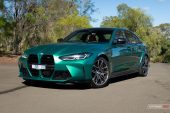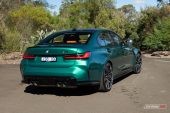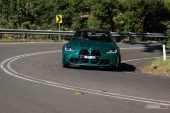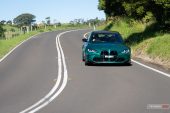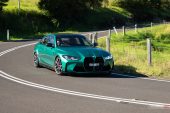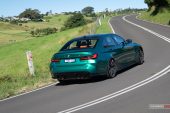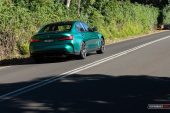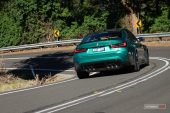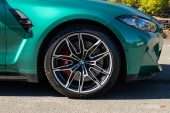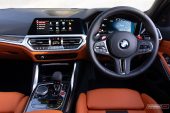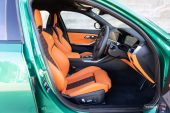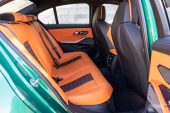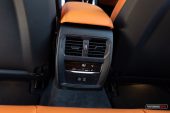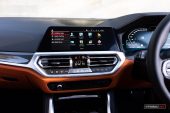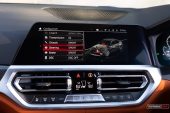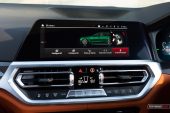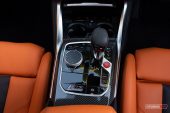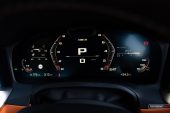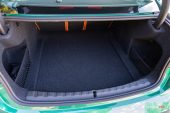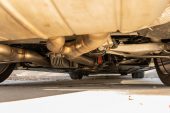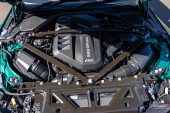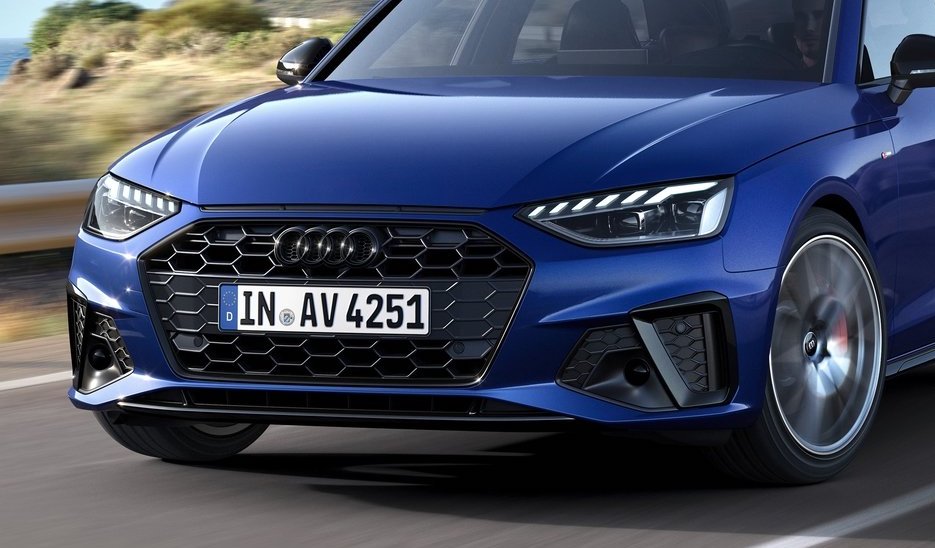Don’t worry about the front grilles. The 2021 BMW M3 Competition is way more than just a set of controversial front intakes. This has the potential to completely reset the benchmark for what is technologically and technically possible for a proper driver’s sedan.

The new M3 switches to BMW’s latest CLAR platform, just like the G20 3 Series on which it is based. That’s an outstanding car as it is, so right from the get-go the new M3 is has hit the ground running. M division has then tweaked and enhanced these sound foundations and applied its own unique flavour, including adding bespoke suspension and chassis reinforcements, completely unique powertrain, and of course upgraded the brakes, wheels and tyres.
BMW Australia is offering not just one variant this time around. You can get the M3 standard with a 353kW engine tune, or the M3 Competition with a 375kW tune, and you can even opt for a manual transmission or xDrive all-wheel drive if you want to – the first-ever AWD M3 (with switchable RWD). There’s also an M3 Touring wagon coming in a couple of years. Needless to say, this is easily the most versatile generation ever offered.
Prices start from $144,900 for the base 353kW manual, and from $154,900 for the M3 Competition (auto only). Prices for the xDrive AWD option are yet to be announced, but it is arriving globally in July, with Australia to follow a bit later. Here we’re testing the Competition auto in rear-wheel drive form.
2021 BMW M3 Competition – THE SPECS
[column width=”47%” padding=”6%”]Engine: 3.0-litre twin-turbo inline-six
Output: 375kW@6250rpm / 650Nm@2750-5500rpm
Transmission: Eight-speed auto
Drive type: Rear-wheel drive, Active M Differential
Wheels: F: 19×9.5, 275/35 R: 20×10.5, 285/30
ANCAP: Not tested (3 Series, 5 stars)
Kerb weight: 1730kg
Power-to-weight: 4.61:1 (kg:kW)
Official fuel economy: 10.2L/100km
Economy during test: 12L/100km
Fuel capacity/Type: 59L/98 RON[/column] [column width=”47%” padding=”0″]Power efficiency: 36.76kW:L/100km
0-60km/h: 2.26 seconds*
0-100km/h: 3.92 seconds*
0-200km/h: 11.65 seconds*
60-110km/h: 2.19 seconds*
1/4 mile: 11.82 seconds at 201.8km/h*
Max acceleration: 1.109g
100-0km/h braking: 2.89 seconds at 35.99 metres*
Max deceleration: -2.037g
Decibel at idle (/Sport mode): 48/55*
Peak decibel at 60-100km/h: 90/94*
Priced from: $154,900[/column][end_columns]
* Figures as tested by PerformanceDrive on the day. Factory claims may be different
2021 BMW M3 Competition – THE PACKAGE
Being based on the latest 3 Series means you get pretty much all of its practicality benefits, only garnished with M division themes. The dash and controls are familiar BMW stuff. Which is great, as it’s all easy to fathom and function. BMW’s latest 7.0 operating system runs on the 10.25-inch touch-able media interface, with the company’s conveniently-positioned iDrive hand controller on the console.
One of the really nice features of the iDrive system is its ability to remember where you last were within the menus. For example, say you’re browsing through the vehicle settings and making changes to the interior mood lighting colours, and you suddenly feel the urge to switch to a different radio station. You simply push the ‘media’ button – one of five jump-to buttons around the main dial – and scroll through to a new channel. Then, when you hit the main ‘menu’ button, it will automatically scroll down to vehicle settings for you so you just press enter and continue where you left off. It then jumps across to the mood lighting menu automatically, too.

It might seem very normal and uninteresting, but there are so many other modern systems out there that require far too many selections to achieve fairly simple tasks. It is excellent to see clever minds working here to cut out some of the distracting functionality deficiencies of modern touch-screens. The menu layouts here are also simple to navigate, further reducing distraction, with four-axis control making it easy to use while driving; scroll up and down using the rotary dial, and nudge the control left or right for sub-menus. There are no randomly-placed widgets or apps, and menu hierarchy is very logical.
As standard the M3 Competition comes with all of the usual apps that you’d expect, like sat-nav, digital radio, traffic updates with online-based ConnectedDrive services, wireless phone charging, and Android Auto and Apple CarPlay. There’s also a 16-speaker sound system by Harman/Kardon, but unfortunately – and typical of BMW – it’s not all that impressive. You also get extended Merino leather upholstery, M Sport seats with power adjustment in the front and driver’s memory function, and multi-zone climate control with pollen filter and solar sensor, complete with temperature control in the back.
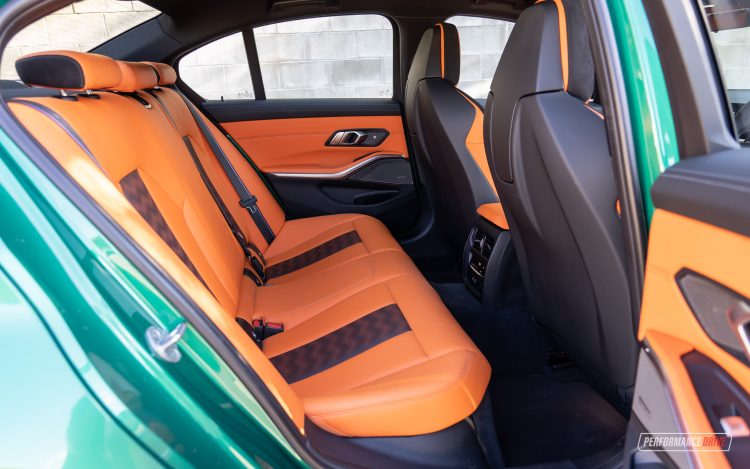
Passenger space is essentially the same as the regular 3 Series, which is to say it is pretty much at the class benchmark. The front seats are a bit chunkier than the standard 3 Series seats but aside from that, you get decent headroom and legroom in the front and back, convenient cup holders and bottle holders, twin USB-C charging ports in the back, and a 480-litre boot (exactly the same as the regular 3 Series).
A carbon fibre roof is standard but you can option for a sunroof if you prefer, at no extra cost. But that removes the carbon roof panel. The interior can also be decorated in carbon fibre, aluminium Tetragon, or Fineline black wood, all at no extra cost. A complete Carbon Package sets you back $26,000, which is obviously insane, but it includes carbon exterior mirrors, carbon race seats, carbon rear spoiler and diffuser, and carbon ceramic brakes (a $16,500 option on its own).
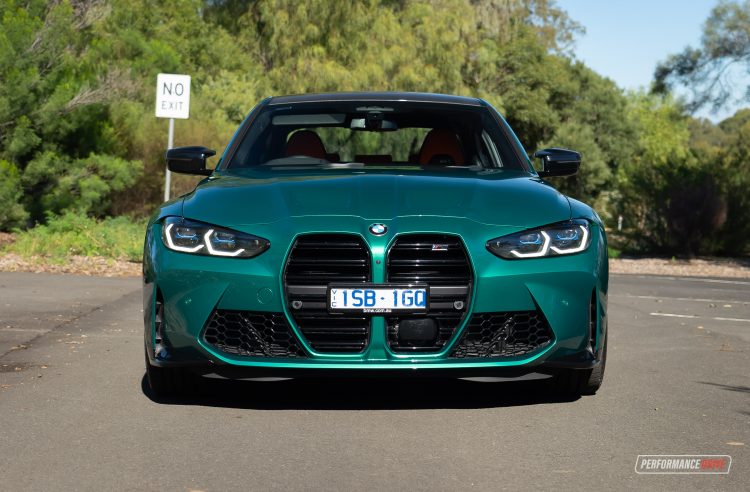
We should probably talk about the front grilles for a moment. We’ll make it quick. We don’t like them. Although we have to admit they do look better in person. Is that like saying, ‘you know what, this turd doesn’t smell as bad as it looks’? Well, we’re certainly not saying the front end resembles faeces, however, we think BMW designers could have done a better job. Perhaps what startles us most is the fact that M3s have always presented a smart and conservative design; they are rarely loud and shouty. Obviously BMW wanted to change this for the G80 generation, perhaps to attract a new generation of buyers.
From the rear it does look superb. It’s well proportioned, with fat rear guards enveloping 20-inch rims that are 10.5 inches wide (19X9.5 on the front). We also like the neat lip spoiler at the back, the aggressive-but-not-too-low front splitter, and the trademark side vents on the swollen front guards. It will be interesting to see how this design (the front end, mainly) ages. Maybe future fashions are steering more towards extravagant and distinctive themes, even if quirky or unusual. Let’s see.
Besides opinionated and subjective criticism, the big front grilles do actually provide improved cooling and performance. Check out the video below for more on this. It’s quite interesting to see the level of attention to detail behind the bumper bar.
2021 BMW M3 Competition – THE DRIVE
There are many alluring factors to the driving experience of this new model. One of the most amazing elements though has to be the powertrain. It’s designed and developed by BMW M, loosely based on BMW’s latest B58 3.0-litre single-turbo inline-six. Codenamed the S58, it replaces the old S55 engine (based on BMW’s old N55), and carries over a bespoke twin-turbocharged configuration. Displacement is up from 2979cc to 2993cc compared with the S55, and the compression ratio drops from 10.2:1 to 9.3:1. A lower compression should help to optimise reliability, while also allowing for higher turbo boost pressure.
Valvetronic fully variable valve timing and double-VANOS variable cam timing help to broaden the engine’s tractability and everyday usability, with two mono-scroll turbochargers supplying boost to cylinders 1-3 and 4-6, respectively. According to the on-board boost gauge they peak at about 26psi (1.8 bar). These provide both massive surging torque as well as relentless top end power. Speaking of which, the engine here develops 375kW at 6250rpm (7200rpm redline cutoff), and 650Nm between 2750-5500rpm. These are some extremely impressive figures for a 3.0L six.
The engine has been made with motorsports and regular track driving in mind. It features a lightweight forged crankshaft for strength and free-revving response, as well as a closed-deck block with sleeveless bores and wire-arc sprayed iron coating to reduce weight, and to ensure minimal friction and wear. The head’s core is made with 3D-printing technology, allowing engineers to create and shape areas with complete flexibility, not possible with traditional metal casting methods. BMW says 3D-printing has also helped reduce weight, and allow intricate coolant tunnels to be routed in ways that more comprehensively optimise thermal management.
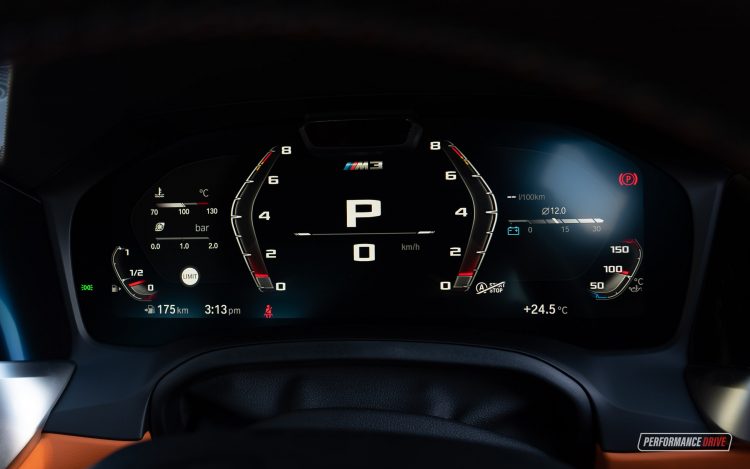
With an advanced High Precision Injection system incorporating high pressure direct injection running at up to 350 bar, and a petrol particulate filter along with an electronic wide-opening wastegate, the new engine is designed to run as cleanly and efficiently as possible (for this performance level). It now meets Euro 6d emissions standards, up from Euro 6. According to Australian Design Rules specifications the new model offers a fuel consumption average of 10.2L/100km, compared with 8.2L/100km in the equivalent predecessor. However, we suspect the difference is due to the application of the newer WLTP measuring standards for this new model. These testing procedures are designed to provide more realistic, real-world results. Emissions have increased from 194g/km to 234g/km. But again, this is likely due to newer testing protocols.
Okay, enough about the technical credibility. There is no doubt this new engine is a superior unit over the old S55. And you can instantly feel it out on the road. Coincidentally, when we jumped out of this M3 when stepped straight into the M2 CS (review coming soon), which features the old 331kW S55 engine. It is a different vehicle but we notice the new engine is much smoother in operation, particularly at low revs and when burbling around the streets. The response of the S58 is also very intense, immediately picking up pace the moment you lean on the throttle. Even in the normal driving mode.
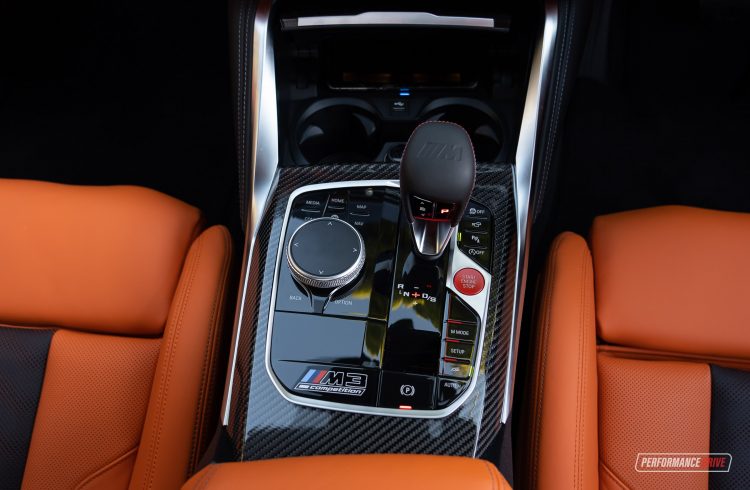
You wouldn’t know it was turbocharged just by driving it, aside from hearing a faint wastegate chuff during throttle lift. Peak torque doesn’t arrive until 2750rpm. But that’s the peak torque. There is still what feels like 500Nm-plus available just off idle. Part of this is thanks to the new eight-speed auto transmission. BMW M has stepped away from a dual-clutch setup and opted for a traditional torque converter unit. Its clutch lock-up is fully engaged as soon as the car moves, so there is zero lag from the transmission off the mark, unlike what was previously experienced in the old seven-speed DCT (and any other dual-clutch unit).
Across the usual acceleration sprints on a private road we clocked 0-100km/h in 3.92 seconds (BMW claims 3.9), and 0-200km/h in 11.65 seconds. The quarter mile was achieved in 11.82 seconds at 201.8km/h. These times compare very well with our previous efforts in the old M3 auto (we didn’t get a chance to test the old Competition version); 0-100km/h in 4.58 seconds and the quarter mile in 12.57 seconds at 191.9km/h.
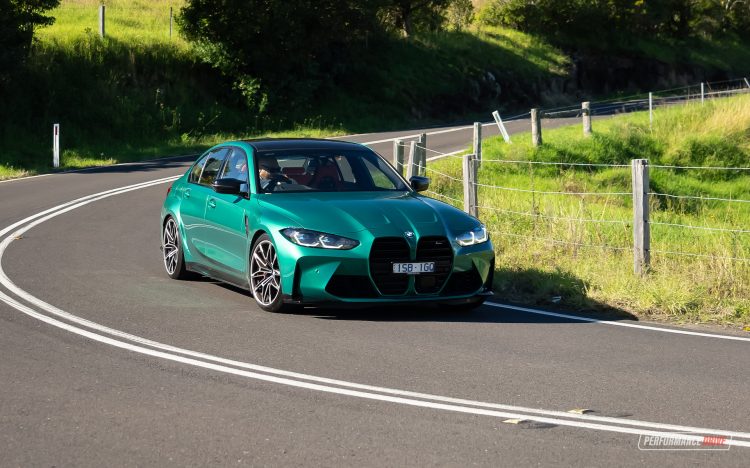
Part of the incredible acceleration (for a rear-wheel drive sedan) comes thanks to the awesome launch control system. Now, the car builds boost during launch control and makes you wait until it’s all there and ready to go. And it automatically starts off in second gear to provide seriously rapid momentum, with almost zero wheelspin – only very minor tyre squirm. According to our Vbox results the car produces 1.1g during acceleration. Usually we only see this sort of force with all-wheel drive cars or mid-/rear-engined rear-drive supercars. It’s nuts.
BMW has increased the tyre widths front and rear to help with traction. At the rear the tyre grows from 275 to 285, which is impressively fat, and now it comes with 275s on the front (up from 255s). In Australia the M3 Competition comes fitted with Michelin Pilot Sport 4 S as standard. As a result, the cornering grip is sensational. It feels very stable and planted at all times, no matter how hard you drive it. On the other hand, the ride comfort is quite good as well. The suspension freely absorbs bumps with very little impact felt in the cabin, and it seems like there is decent wheel travel so it doesn’t bottom-out.
Yes, the M3 does feature electronic power steering. Though, BMW has obviously worked hard to remove as much of that artificial feel that you often get from EPS systems, as there is plenty of communication here. Turn-in is fluid and consistent, with a good balance of response and precision that’s not overly fidgety or touchy. Compared with the old model, this feels more predictable, and automatically dials in counter-steer during drifting, and smoothly returns to centre when you straighten up. In the old model you had to actively dial out the oversteer a bit more, and then centre the steering in a somewhat rushed manner. That all sounds like this is less active and engaging, but it’s really not. It is simply more predictable and anticipates your intensions better than before.
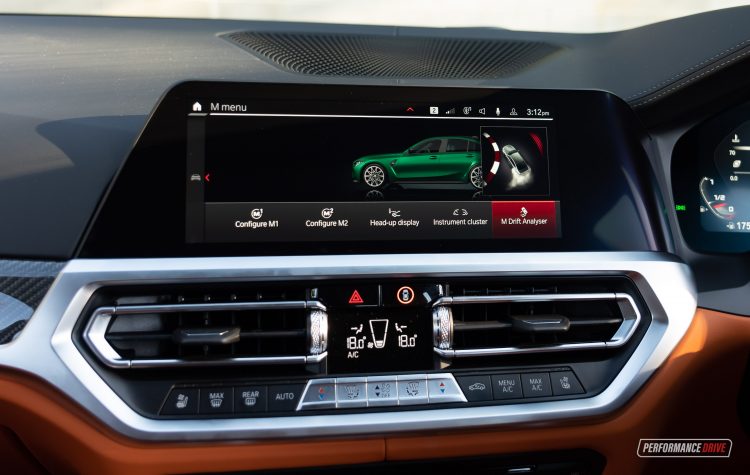
There is a ‘drift analyser’ to play with, and BMW has introduced a multi-stage traction/stability control system with 10 different settings. The mid-level setting allows for a surprisingly big angle of drift, but it won’t let things get out of hand or turn into a hairy-chested powerslide. You can of course, when you’re ready, switch it completely off.
Thanks to the less-touchy and more predictable steering, and increased engine torque, drifting can now easily be provoked in third gear. Poke the steering in sharply and prod the throttle and it will kick out progressively, and remain out until the gear is finished or until you ease off the pedal. The Active M differential never skips a beat either, always hooking up both wheels. It doesn’t get much better than this for a stock-standard sedan, in this department. Check out the promo video below with two drifters taking the new M3 and M4 for a trash.
So, what are the downsides to the driving experience? Well, the new model is about 170kg heavier than the equivalent predecessor (kerb: 1730kg vs 1560kg). That never looks good on paper. Fortunately, it doesn’t feel that much heavier than before. The weight would no doubt impact fuel economy though, as well as performance, braking, and agility – imagine if it had the same components, with a 375kW engine and so on, but weighed 1560kg. A boost in technologies and luxuries obviously contribute to the weight gain.
The only other element we would change is the fake engine sounds in the cabin. BMW, seriously, there’s no need for them. Fire whoever is in charge of this stuff. The soundtrack at the tailpipe end is brilliant as it is. It doesn’t need artificial sweeteners.
2021 BMW M3 Competition – THE VIDEO
2021 BMW M3 Competition – THE VERDICT
If you’re in the market for a mid-size performance sedan this is the one you should buy. It is, without a moment of hesitation, the one we’d buy. Why? Well, without meaning to criticise the key rivals on purpose, as this is not a comparison; one of its main German rivals is old and the other is a bit boring, and the Italian offering is a great first crack but a bit too sensitive and emotional for this template of vehicle. That’s all in comparison to the overall broad range of favourable characteristics presented here. It’s fast, fun, luxurious, practical, and, above all, a true driver’s car at heart. The benchmark has been reset.
[column width=”47%” padding=”6%”]PROS:
– More predictable rear end traction, yet still loves to drift if you desire
– Switch to torque converter auto helps in town, more comfortable
– Gut-wrenching acceleration and top-end pull
– Smooth, natural-feeling electronic steering
– Decent ride comfort for a hardcore sedan
– Practical and feature-packed cabin
[/column] [column width=”47%” padding=”0″]CONS:
– Controversial front grilles
– Much heavier than before (although you don’t really feel it)
– Average sound system[/column][end_columns]
As always, if you’re thinking about buying a new car don’t forget to click here to speak with our car buying specialists.


